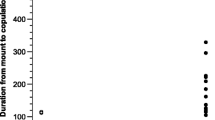Abstract
Male-male interaction (K) has been estimated from data on the attrition rate of virgin females per minute in a study of the mating kinetics inDrosophila. K is expressed as the time males expend on other males relative to that expended while searching for, courling, and copulating with females. The value of K in these studies ranged from 0 (approximately) to. 695; it was affected both by strain (sepia orebony D. melanogaster and wild-typeD. simulans) and by size of the mating chamber. Host-parasitoid models of ecologists appear to be appropriate for examining mating kinetics inDrosophila.
Similar content being viewed by others
References
Cobb, M., Burnet, B., and Connally, K. (1986). The structure of courtship in theDrosophila melanogaster species subgroup.Behaviour 97:182–212.
Crossley, S. (1986). Courtship sounds and behaviour in the four species of theDrosophila bipectinata complex.Anim. Behav. 34:1146–1159.
Dowse, H. B., Ringo, J. M., and Barton, K. M. (1986). A model describing the kinetics of mating inDrosophila.J. Theor. Biol. 121:173–183.
Eckstrand, I. A., and Seiger, M. B. (1975). Population density and mating rates inDrosophila pseudoobscura.Evolution 29:287–295.
Hassell, M. P. (1978).The Dynamics of Arthropod Predator-Prey Systems, Princeton University Press, Princeton, N.J.
Holling, C. S. (1959). Some characteristics of simple types of predation and parasitism.Can. Entomol. 91:385–398.
Jallon, J.-M. (1984). A few chemical words exchanged byDrosophila during courtship and mating.Behav. Genet. 14:411–478.
Jallon, J.-M. and David, J. R. (1987). Variations in cuticular hydrocarbons among the eight species of theDrosophila melanogaster subgroup.Evolution 41:294–302.
Kawanishi, M., and Watanabe, T. K. (1980). Genetic variations of courtship song ofDrosophila melanogaster andDrosophila simulans.Jap. J. Genet. 55:235–240.
Kawanishi, M., and Watanabe, T. K. (1981). Genes affecting courtship song and mating preference inDrosophila melanogaster, Drosophila simulans, and their hybrids.Evolution 35:1128–1133.
Kyriacou, C. P., and Hall, J. C. (1982). The function of courtship song rhythms inDrosophila.Animal Behav. 30:794–801.
Markow, T. A. (1987). Behavioral and sensory basis of courtship success inDrosophila melanogaster.Proc. Natl. Acad. Sci. USA 84:6200–6204.
Markow, T. A., and Hanson, S. J. (1981). Multivariate analysis ofDrosophila courtship.Proc. Natl. Acad. Sci. USA 78:430–434.
Ringo, J. M., Dowse, H. B., and Barton, K. M. (1987). Courtship behavior and the kinetics of mating in three lines ofDrosophila simulans and their hybrids.Behav. Genet. 17:141–154.
Shorey, H. H., and Bartell, R. J. (1970). Role of a volatile sex pheromone in stimulating male courtship behavior inDrosophila melanogaster.Anim. Behav. 18:159–164.
Spieth, H. T. (1952). Mating behavior within the genusDrosophila (Diptera).Bull. Am. Mus. Nat. Hist. 99:399–474.
Spieth, H. T. (1982). Behavioral biology and evolution of the Hawaiian picture-winged species group ofDrosophila.Evol. Biol. 14:351–437.
Sturtevant, A. H. (1915). Experiments on sex recognition and the problem of sexual selection inDrosophila.J. Anim. Behav. 5:351–366.
Taylor, C. E. (1975). Differences in mating propensities: Some models for examining the genetic consequences.Behav. Genet. 5:381–393.
Wallace, B. (1985). Mating kinetics inDrosophila.Behav. Sci. 30:149–154.
Wilbergen, P., Van Dijken, F. R., and Scharloo, W. (1987). Collation of courtship behavior of the sympatric speciesDrosophila melanogaster andD. simulans.Behaviour 101:253–274.
Wood, D., Ringo, J. M., and Johnson, L. L. (1980). Analysis of courtship sequences of the hybrids betweenDrosophila melanogaster andDrosophila simulans.Behav. Genet. 10:459–466.
Zawistowski, S., and Richmond, R. C. (1986). Inhibition of courtship and mating ofDrosophila melanogaster by the male-produced lipid,cis-vacceryl acetate.J. Insect Physiol. 32:189–192.
Author information
Authors and Affiliations
Additional information
Work reported here was supported by Grant GM34576, National Institute of General Medical Science, U.S. Public Health Services.
Rights and permissions
About this article
Cite this article
Wallace, B. Male-male interactions and mating kinetics inDrosophila . Behav Genet 20, 405–421 (1990). https://doi.org/10.1007/BF01065566
Received:
Accepted:
Issue Date:
DOI: https://doi.org/10.1007/BF01065566




